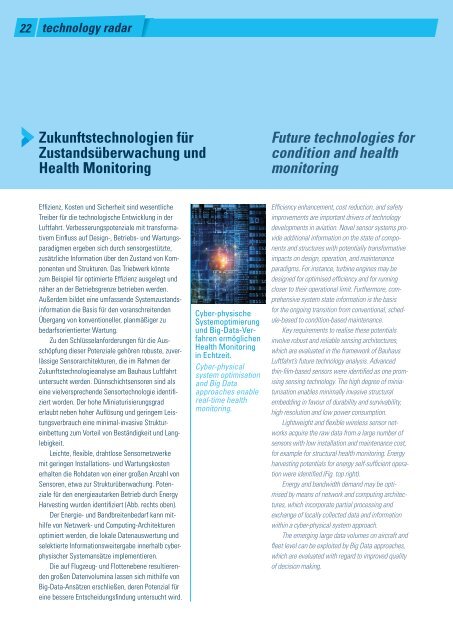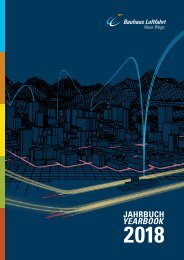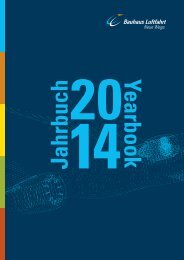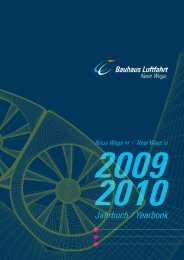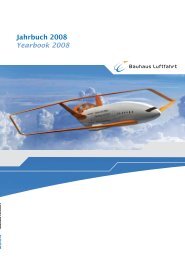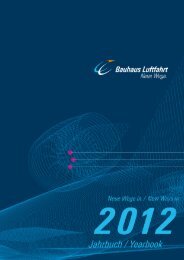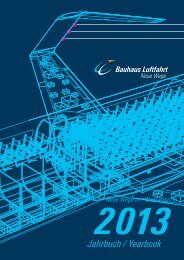Jahrbuch Bauhaus Luftfahrt 2016
Sie wollen auch ein ePaper? Erhöhen Sie die Reichweite Ihrer Titel.
YUMPU macht aus Druck-PDFs automatisch weboptimierte ePaper, die Google liebt.
22 technology radar<br />
Zukunftstechnologien für<br />
Zustandsüberwachung und<br />
Health Monitoring<br />
Future technologies for<br />
condition and health<br />
monitoring<br />
Effi zienz, Kosten und Sicherheit sind wesentliche<br />
Treiber für die technologische Entwicklung in der<br />
<strong>Luftfahrt</strong>. Verbesserungspotenziale mit transformativem<br />
Einfluss auf Design-, Betriebs- und Wartungsparadigmen<br />
ergeben sich durch sensorgestützte,<br />
zusätzliche Information über den Zustand von Komponenten<br />
und Strukturen. Das Triebwerk könnte<br />
zum Beispiel für optimierte Effizienz ausgelegt und<br />
näher an der Betriebsgrenze betrieben werden.<br />
Außerdem bildet eine umfassende Systemzustandsinformation<br />
die Basis für den voranschreitenden<br />
Übergang von konventioneller, planmäßiger zu<br />
bedarfsorientierter Wartung.<br />
Zu den Schlüsselanforderungen für die Ausschöpfung<br />
dieser Potenziale gehören robuste, zuverlässige<br />
Sensorarchitekturen, die im Rahmen der<br />
Zukunftstechnologieanalyse am <strong>Bauhaus</strong> <strong>Luftfahrt</strong><br />
untersucht werden. Dünnschichtsensoren sind als<br />
eine vielversprechende Sensortechnologie identifiziert<br />
worden. Der hohe Miniaturisierungsgrad<br />
erlaubt neben hoher Auflösung und geringem Leistungsverbrauch<br />
eine minimal-invasive Struktureinbettung<br />
zum Vorteil von Beständigkeit und Langlebigkeit.<br />
Leichte, flexible, drahtlose Sensornetzwerke<br />
mit geringen Installations- und Wartungskosten<br />
erhalten die Rohdaten von einer großen Anzahl von<br />
Sensoren, etwa zur Strukturüberwachung. Potenziale<br />
für den energieautarken Betrieb durch Energy<br />
Harvesting wurden identifiziert (Abb. rechts oben).<br />
Der Energie- und Bandbreitenbedarf kann mithilfe<br />
von Netzwerk- und Computing-Architekturen<br />
optimiert werden, die lokale Datenauswertung und<br />
selektierte Informationsweitergabe innerhalb cyberphysischer<br />
Systemansätze implementieren.<br />
Die auf Flugzeug- und Flottenebene resultierenden<br />
großen Datenvolumina lassen sich mithilfe von<br />
Big-Data-Ansätzen erschließen, deren Potenzial für<br />
eine bessere Entscheidungsfindung untersucht wird.<br />
10 um<br />
Cyber-physische<br />
Systemoptimierung<br />
und Big-Data-Verfahren<br />
ermöglichen<br />
Health Monitoring<br />
in Echtzeit.<br />
Cyber-physical<br />
system optimisation<br />
and Big Data<br />
approaches enable<br />
real-time health<br />
monitoring.<br />
Efficiency enhancement, cost reduction, and safety<br />
improvements are important drivers of technology<br />
developments in aviation. Novel sensor systems provide<br />
additional information on the state of components<br />
and structures with potentially transformative<br />
impacts on design, operation, and maintenance<br />
paradigms. For instance, turbine engines may be<br />
designed for optimised efficiency and for running<br />
closer to their operational limit. Furthermore, comprehensive<br />
system state information is the basis<br />
for the ongoing transition from conventional, schedule-based<br />
to condition-based maintenance.<br />
Key requirements to realise these potentials<br />
involve robust and reliable sensing architectures,<br />
which are evaluated in the framework of <strong>Bauhaus</strong><br />
<strong>Luftfahrt</strong>’s future technology analysis. Advanced<br />
thin-film-based sensors were identified as one promising<br />
sensing technology. The high degree of miniaturisation<br />
enables minimally invasive structural<br />
embedding in favour of durability and survivability,<br />
high resolution and low power consumption.<br />
Lightweight and flexible wireless sensor networks<br />
acquire the raw data from a large number of<br />
sensors with low installation and maintenance cost,<br />
for example for structural health monitoring. Energy<br />
harvesting potentials for energy self-sufficient operation<br />
were identified (Fig. top right).<br />
Energy and bandwidth demand may be optimised<br />
by means of network and computing architectures,<br />
which incorporate partial processing and<br />
exchange of locally collected data and information<br />
within a cyber-physical system approach.<br />
The emerging large data volumes on aircraft and<br />
fleet level can be exploited by Big Data approaches,<br />
which are evaluated with regard to improved quality<br />
of decision making.


